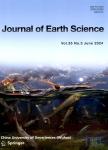Late Triassic(Norian)Conodont Apparatuses Revealed by Conodont Clusters from Yunnan Province,Southwestern China
Late Triassic(Norian) Conodont Apparatuses Revealed by Conodont Clusters from Yunnan Province, Southwestern China作者机构:State Key Laboratory of Biogeology and Environmental GeologyChina University of GeosciencesWuhan 430078China School of Earth SciencesChina University of GeosciencesWuhan 430074China Department of GeologyUniversity of LeicesterLeicester LEI 7RHUK
出 版 物:《Journal of Earth Science》 (地球科学学刊(英文版))
年 卷 期:2021年第32卷第3期
页 面:709-724页
核心收录:
学科分类:070903[理学-古生物学与地层学(含:古人类学)] 0709[理学-地质学] 07[理学] 0708[理学-地球物理学] 0704[理学-天文学]
基 金:supported by the National Natural Sciences Foundation of China(Nos.41830320 41972033 41572324)。
主 题:conodont apparatus Mockina Parvigondolella Misikella Triassic
摘 要:Almost all aspects of conodont research rely on a sound taxonomy based on comparative analysis.This is founded on hypotheses of homology which ultimately rest on knowledge of the location of elements in the apparatus.Natural assemblages—fossils that preserve the articulated remains of the conodont skeletal apparatus—provide our only direct evidence for element location,but very few are known from the Late Triassic.Here we describe fused clusters(natural assemblages)from the late Norian limestone beds of the Nanshuba Formation in Baoshan,Yunnan Province,southwestern China.Recurrent arrangements and juxtaposition of S and M elements in multiple clusters reveal the composition of the apparatus of Mockina and,probably,Parvigondolella.They indicate that these taxa had a standard 15 elements ozarkodinid apparatus,and provide new insights into the morphology of the elements occupying the P2,M and S locations of the apparatus.The apparatus comprised a single alate(hibbardelliform)S0 element,paired breviform digyrate(grodelliform)S1 and(enantiognathiform)S2 elements,paired bipennate(hindeodelliform)S3 and S4 elements,paired breviform digyrate(cypridodellifrom)M elements,paired,modified-angulate P2 elements(with reduced or lacking‘posterior’process)and segminiplanate(mockiniform and parvigondolelliform)P1 elements.Our results will allow testing of the hypothesis that Mockina,Parvigondolella and Misikella—critical taxa in Late Triassic biostratigraphy—are closely related and possessed morphologically similar elements in homologous locations.



